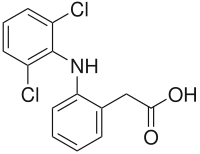Pennsaid
 |
|
| Clinical data | |
|---|---|
| Trade names | Aclonac, Cataflam, Voltaren, see trade names |
| AHFS/Drugs.com | Monograph |
| MedlinePlus | a689002 |
| Pregnancy category |
|
| Routes of administration |
oral, rectal, intramuscular, intravenous (renal- and gallstones), topical |
| ATC code | |
| Legal status | |
| Legal status | |
| Pharmacokinetic data | |
| Protein binding | More than 99% |
| Metabolism | hepatic, oxidative, primarily by CYP2C9, also by CYP2C8, CYP3A4, as well as conjugative by glucuronidation (UGT2B7) and sulfation; no active metabolites exist |
| Biological half-life | 1.2-2 hr (35% of the drug enters enterohepatic recirculation) |
| Excretion | 40% biliary 60% urine |
| Identifiers | |
|
|
| CAS Number | |
| PubChem CID | |
| IUPHAR/BPS | |
| DrugBank | |
| ChemSpider | |
| UNII | |
| KEGG | |
| ChEBI | |
| ChEMBL | |
| PDB ligand | |
| ECHA InfoCard | 100.035.755 |
| Chemical and physical data | |
| Formula | C14H11Cl2NO2 |
| Molar mass | 296.148 g/mol |
| 3D model (Jmol) | |
|
|
|
|
|
|
|
Diclofenac (sold under a number of trade names) is a nonsteroidal anti-inflammatory drug (NSAID) taken or applied to reduce inflammation and as an analgesic reducing pain in certain conditions. It is supplied as or contained in medications under a variety of trade names.
The name "diclofenac" derives from its chemical name: 2-(2,6-dichloranilino) phenylacetic acid. Diclofenac was first synthesized by Alfred Sallmann and Rudolf Pfister and introduced as Voltaren by Ciba-Geigy (now Novartis) in 1973.
In the United Kingdom, United States, India, and Brazil diclofenac may be supplied as either the sodium or potassium salt; in China, it is most often supplied as the sodium salt, while in some other countries it is only available as the potassium salt. It is available as a generic drug in a number of formulations, including diclofenac diethylamine, which is applied topically. Over-the-counter (OTC) use is approved in some countries for minor aches and pains and fever associated with common infections. As of 2015 the cost for a typical month of medication in the United States is 50 to 100 USD.
The drug's use in animals is controversial due to its toxicity which can rapidly kill scavenging birds that may eat dead animals. It has been banned for veterinary use in many countries.
Diclofenac is used to treat pain, inflammatory disorders, and dysmenorrhea.
Inflammatory disorders may include musculoskeletal complaints, especially arthritis, rheumatoid arthritis, polymyositis, dermatomyositis, osteoarthritis, dental pain, temporomandibular joint (TMJ) pain, spondylarthritis, ankylosing spondylitis, gout attacks, and pain management in cases of kidney stones and gallstones. An additional indication is the treatment of acute migraines. Diclofenac is used commonly to treat mild to moderate postoperative or post-traumatic pain, in particular when inflammation is also present, and is effective against menstrual pain and endometriosis.
...
Wikipedia
